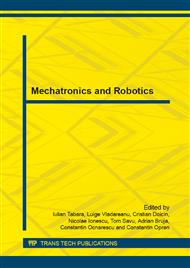[1]
V Kumar, K. J Waldron, Force Distribution in Walking Vehicle, Proc. 20th ASME Mechanism Conference, Orlando, Florida (1988).
Google Scholar
[2]
I. Doroftei, A. Preumont, P Alexandre. On Choosing the Terrain adaptability of a Six-Legged Walking Robot In the Seventh IFToMM International Symposium on Linkages and Computer Aided Design Methods Theory and Practice of Mechanisms SYROM '97, Bucureşti (1997).
Google Scholar
[3]
I. Ion, I. Simionescu, Robot marchant modulaire -Medaille d'Or Salon Intenational des Inventions Geneve, Suisse April 4-9 , (2006).
Google Scholar
[4]
I. Ion, I. Simionescu, A. Curaj, A. Vasile MERO Modular Walking Robots, Solution for Displacing Technological Equipments on Irregular Terrains Proceedings of the 13th World Congress in Mechanism and Machine Science Guanajuato, México, 19-25 June, (2011).
DOI: 10.1007/3-540-26415-9_81
Google Scholar
[5]
I. Ion, I. Simionescu, A. Curaj. Mobil Mechatronic System with Applications in Agriculture and Sylviculture. The 2thIFAC International Conference on Mechatronic Systems, December 8-12, - Berkeley University – USA (2002).
DOI: 10.1016/s1474-6670(17)34048-x
Google Scholar
[6]
I. Ion, M. Gavan, C. Dinu, A. Vasile, O. Nicola. I. Dumitru, G. Stamatescu Device for sensing and motion control walking robot attached to the displacement 07/02/2013 nr. A/00132 (2013).
Google Scholar
[7]
I. Ion, I. Simionescu, A. Curaj, L. Vladareanu, A. Vasile Distribution of reaction forces during movement walking robots FIELD ROBOTICS; Proceedings of the 14th International Conference on Climbing and Walking Robots and the Support Technologies for Mobile Machines, University Pierre et Marie Curie UPMC Paris France 6-8 September (2011).
DOI: 10.1142/9789814374286_0007
Google Scholar
[8]
I. Ion., A. Curaj, A. Vasile, I. Dumitru, G. Stamatescu Force Sensing and Control during Movement and Object Manipulation in MERO walking robots, The 15th International Conference on Climbing and Walking Robots, Sydney, Australia 602-608 (2013).
DOI: 10.1142/9789814525534_0082
Google Scholar
[9]
R. B McGhee, G. I., Iswandhi, . Adaptive Locomotion of a Multilegged Robot Over Rough Terrain, IEEE Trans. on Systems, Man, and Cybernteics, Vol. SMC-9, No. 4, pp.76-182. (1979).
DOI: 10.1109/tsmc.1979.4310180
Google Scholar
[10]
A. Mahdi., N. Stephen. Foot Force Criterion for Robot Stability Proceedings of the 13th International Conference on Climbing and Walking robots and the Support Technologies for Mobile Machines CLAWAR 2012, Baltimore USA (2012).
DOI: 10.1108/ir.2006.33.4.321.1
Google Scholar
[11]
D.E., Orin, C. K Tsai, F. Y Cheng, Dynamic Computer, Control of a Robot Leg, Proceeding IECON'83, San Francisco(1983).
Google Scholar
[12]
D. E Okhotsimski, A. K Platonov, Control Algorithm of the Walking Climbing Over Obstacles Proceeding of the International Conference on Artificial Intelligence, Stanford - (1973).
Google Scholar
[13]
M Sandu, A. Sandu, M. Gavan Proiectarea senzorilor cu traductoare rezitive Printech Press (2005).
Google Scholar
[14]
I. Simionescu, I. Ion, L Ciupitu. Mechanism of Industrial Robots, Published by AGIR Press Bucharest -In Romanian. (Tome1, 2008).
Google Scholar
[15]
K.J. Waldron, Force and Motion Management in Legged Locomotion, Proceedings of 24 th IEEE Conference on Decision and Control, Fort Lauderdale, pp.12-17. (1985).
DOI: 10.1109/cdc.1985.268463
Google Scholar
[16]
Information on http: /www. Catalogue Walking Machines.
Google Scholar


